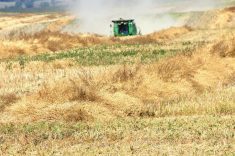REGINA – And then there were four.
Thirty seven years after the start of a small, regional prairie cattle show, Canadian Western Agribition in Regina has grown into one of the world’s largest annual livestock events.
Throughout those years, only four families are known to have shown purebred cattle at each show every year.
“Something is bound to come up in one year or another. People retire, people die, businesses change or folks decide to miss a show one year in favour of another one,” said Robert Ballantyne of Diamond B Ranches at Livelong, Sask.
Read Also

Alberta researcher helps unlock the economics of farming
Lethbridge Polytechnic researcher helping agriculture producers with decision-making tools in economic feasibility
Ballantyne, a Galloway breeder, said his family decided to make Agribition part of their marketing from the first year and have remained happy with that decision.

Angus breeder Jimmy Grant of Edam, Sask., said he was only a kid when the show started.
“It was a lot smaller. A lot colder. The barns were pretty basic. Today we’ve got great facilities, and we sleep in hotels. Global warming has been good for Agribition with its late November dates,” he said.
In its early years, most producers brought trailers or truck campers to Regina for the show.
Kevin Dorrance of Wawota, Sask., recalled the cold of those first years.
“We slept in the camper. Today we stay with family in Regina. But then, every morning it was a challenge, everything was frozen down, nothing seemed to come easily,” said the Angus producer.
David Johner of Maidstone, Sask., breeds Hereford and Angus cattle. He remembers the first year well.
“All our water was frozen. We were asking ourselves if a late fall show was really such a good idea. It was,” he said.
Grant said Agribition has undergone many changes since its early days.
“In the 1980s and 1990s, we had barns full of double muscled cattle and stuff like Chianina. We’ve seen folks get excited about miniature cattle. Trends have come and gone and we’ve got about a dozen breeds in the (show) barns today,” he said.
From a few hundred animals for a three-day show at the start, the event has grown to more than 4,000 head over six days.
Johner said the rise of the all-breeds events creates a chance to compare the best of each breed from shows across the country and that attracts more interest.
“If this border is open, then we’ll get more American cattle up here again. Most important, we’ll get more American buyers back.”
Johner said Agribition’s place internationally as a major beef show developed over time and now it’s a necessary marketing tool that draws him and his son, Justin, back each year.
This year, the event is expected to register more than 400 international visitors from 15 nations and 16 U.S. states. Auction sales of live animals at Agribition are expected to bring in more than $2 million and add more than $16 million to the local economy.
Bison, heavy horse events, goats, sheep, stock dogs and until a few years ago poultry, hogs, elk, llama and even ostrich all had a place at the event. Dairy cattle aren’t part of the show this year.
“Agribition was created to showcase beef cattle and despite any dalliances with other sectors, will always be about beef cattle,” Grant said.














